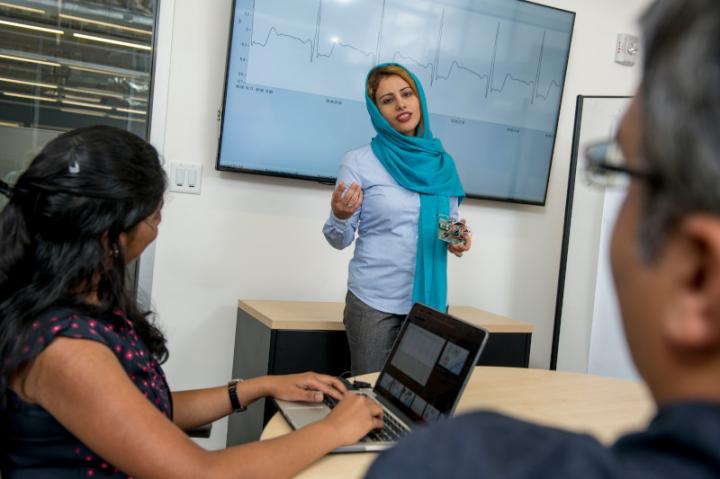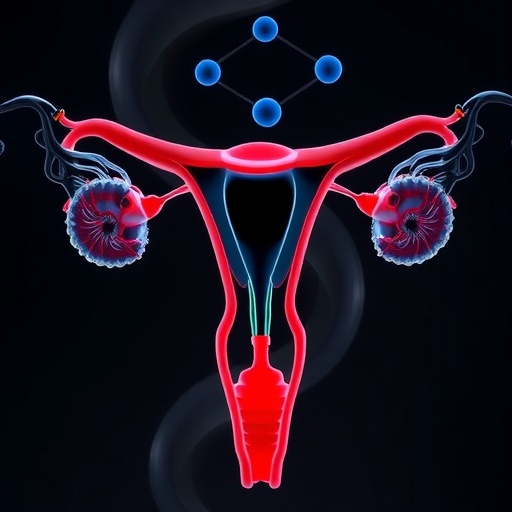Project will develop small, inexpensive, artificially intelligent drone systems that can observe, understand, adapt and respond to changing environments on their own, and communicate with other autonomous vehicles to perform more sophisticated missions

Credit: Northern Arizona University
Fatemeh Afghah, an associate professor in the School of Informatics, Computing, and Cyber Systems (SICCS) at Northern Arizona University, has received a $550,000 grant through the National Science Foundation’s (NSF) Faculty Early Career Development (CAREER) Program, one of the foundation’s most prestigious awards. The funding will support a project developing algorithms that will enable a fleet of smart and autonomous drones to assess situations, change course, stand up against environmental factors like wind, communicate with other drones and coordinate a strategy together, all with limited support from humans.
The NSF presents CAREER awards to early career faculty members who have the potential to serve as academic role models in research and education, and to lead advances in the mission of their department or organization.
“Dr. Afghah has established an excellent track record in the classroom and in her research in her time at NAU, and is an emerging leader especially in the important area of autonomous vehicles. We’re proud to have her as a key member of the faculty in SICCS,” said SICCS director and professor Ben Ruddell.
Afghah says drones, or unmanned aerial vehicles (UAVs), increasingly are being used for activities such as delivering packages, monitoring traffic, patrolling borders and maneuvering through difficult terrain or hazardous conditions.
“They can be particularly useful in unstructured and unknown environments to provide agile surveying in natural disasters and search-and-rescue operations.” But, she adds, because drones rely heavily on a human controller to program where they go and what they do, their effectiveness is limited.
Afghah’s goal is to develop small, inexpensive, artificially intelligent drone systems that can observe, understand, adapt and respond to changing environments on their own, and communicate with other autonomous vehicles to perform more sophisticated missions.
“UAVs will be able to do the take-off, landing and task management all by themselves. If they are in a remote environment like a forest fire or disaster area, they will be able to inspect the area, conduct imaging or other tasks and coordinate between multiple UAVs–we don’t want them all taking images of the same thing,” Afghah said. “Instead of using expensive aircraft with a pilot, we will be able to use multiple small UAVs capable of making the optimum decision in a given situation and determining the best coordination strategy with their teammates.”
To enable the operation of a network of drones, Afghah says reliable communication is necessary among the UAVs and between the UAVs and the ground station to transmit videos and images they collect.
“If we have a specific disaster, the default communication system may not be working. We need to be working on new communication techniques so drones can talk with each other. This type of communication requires high transmission rates and therefore a large radio bandwidth,” she said. “We will focus on developing spectrum management and co-existence strategies to facilitate drones’ communication using 4G and 5G networks.”
The five-year research project, scheduled to begin in mid-August, will have multiple phases. Afghah and her team will develop and test methods using computer simulations, and then implement them on drones and test them indoors in a laboratory on campus and outdoors in the Centennial Forest near The Arboretum in Flagstaff.
“We hope to have a proof-of-concept network of multiple drones that can handle coordination, communication and different missions such as target tracking, remote sensing and package delivery in an autonomous manner,” Afghah said.
The project also offers opportunities for educational and outreach activities to engage elementary and middle school students through hands-on drone demonstrations and create enhanced public awareness about better technologies and new uses for UAVs.
###
About Northern Arizona University
Northern Arizona University is a higher-research institution providing exceptional educational opportunities in Arizona and beyond. NAU delivers a student-centered experience to its 31,000 students in Flagstaff, statewide and online through rigorous academic programs in a supportive, inclusive and diverse environment. Dedicated, world-renowned faculty help ensure students achieve academic excellence, experience personal growth, have meaningful research opportunities and are positioned for personal and professional success.
Media Contact
Diane Rechel
[email protected]
Original Source
https:/




